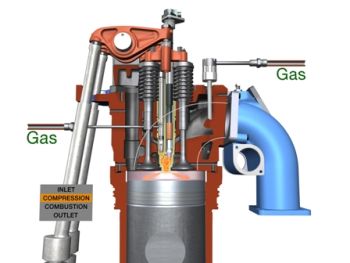
Wärtsilä gas-fired engines The new Wärtsilä 50SG is a four-stroke, spark-ignited gas engine operating on the Otto cycle and incorporating the lean-burn principle. It has been designed using the proven gas technology used in the smaller Wärtsilä 34SG engine. An important feature of this new gas engine in Wärtsilä’s portfolio is its exceptionally high power plant net electrical efficiency rating - more than 50% in combined-cycle mode.
World's largest gas engine - Wärtsilä 50SG
With the launch of the Wärtsilä 18V50SG gas engine, Wärtsilä now has two high-output, highly efficient prime movers when entering the market for large-scale power generation. The new Wärtsilä 18V50SG is the world’s largest gas-powered generating set and is ideally suited for use in locations where a constant supply of gas is assured. On the other hand, when gas supplies cannot be guaranteed under all circumstances, the dual-fuel Wärtsilä 50DF is the right choice. Read more about the Wärtsilä 50SG engine from the article - World's largest gas engine.
The lean-burn gas engines (SG) feature port admission of gas, prechamber with controlled gas flow as well as individual cylinder control of gas charge and ignition timing. This choice of concept along with extensive research in combustion and combustion control has made it possible to elevate the efficiency from 40% to more than 48% in the bigger engine models. The combination of high efficiency and low emissions is probably unequalled in the market.
Engine working principle of spark-ignited engines (SG)
The SG engines are spark-ignited lean-burn otto cycle gas engines. In this process, the gas is mixed with air before the inlet valves. During the intake period, gas is also fed into a small prechamber, where the gas mixture is rich compared to the gas in the cylinder. At the end of the compression phase the gas/air mixture in the prechamber is ignited by a spark plug. The flames from the nozzle of the prechamber ignite the gas/air mixture in the whole cylinder. After the working phase the cylinder is emptied of exhaust and the process starts again.
We use cookies to improve your experience. By continuing to use our site, you accept our Cookies, Privacy Policy,Terms and Conditions. Close X